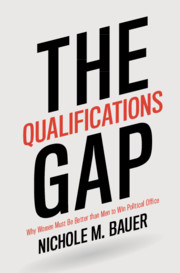Book contents
- The Qualifications Gap
- The Qualifications Gap
- Copyright page
- Dedication
- Contents
- Figures
- Tables
- Acknowledgments
- 1 The Gendered Qualification Gap
- 2 Fomenting a Gender Rebellion
- 3 No Place for Women
- 4 A Gendered Information Gap
- 5 Do Voters Expect Women to Be Better than Men?
- 6 Different Parties, Different Standards
- 7 Gender Bias, Disrupted
- 8 The Future Is Female
- Appendixes
- References
- Index
3 - No Place for Women
Published online by Cambridge University Press: 17 July 2020
- The Qualifications Gap
- The Qualifications Gap
- Copyright page
- Dedication
- Contents
- Figures
- Tables
- Acknowledgments
- 1 The Gendered Qualification Gap
- 2 Fomenting a Gender Rebellion
- 3 No Place for Women
- 4 A Gendered Information Gap
- 5 Do Voters Expect Women to Be Better than Men?
- 6 Different Parties, Different Standards
- 7 Gender Bias, Disrupted
- 8 The Future Is Female
- Appendixes
- References
- Index
Summary
Chapter 3 addresses the question: How do ideas about gender, namely femininity and masculinity, affect what it means, from the voter’s perspective, to be qualified for political office? I apply social role theory to the development of political leadership in the United States to show how masculinity determines the expectations voters have for what a qualified political candidate looks like. Ideas about femininity and masculinity shape the expectations individuals hold for the different types of roles and occupations women and men hold. Caregiving roles are bound up in norms of femininity, and there is an intrinsic link between masculinity and leadership roles. The expectation that leaders have masculine qualities extends back to America’s founding and, indeed, well before the United States came into existence. I use two empirical tests of how masculinity influences thinking about political leadership and qualifications.
Keywords
- Type
- Chapter
- Information
- The Qualifications GapWhy Women Must Be Better than Men to Win Political Office, pp. 41 - 62Publisher: Cambridge University PressPrint publication year: 2020

